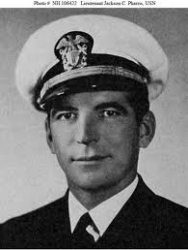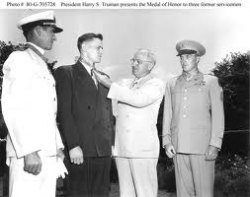
 |
|
|
||
|
Jackson Charles Pharris |
||||
|
Engagements: • World War II (1941 - 1945) |
||||
| Biography: | ||||
|
Jackson Charles Pharris Lieutenant Commander, U.S. Navy Medal of Honor Recipient World War II Lieutenant Commander Jackson Charles Pharris (26 June 1912 - 17 October 1966) was a U.S. Navy officer who received the U.S. military's highest award for valor, the Medal of Honor, for heroism during the attack on Pearl Harbor. Jackson Charles Pharris was born on 26 June 1912 in Columbus, GA, the oldest of five children. He joined the Navy on 25 April 1933. In September 1933, he reported aboard the USS California (BB-44) as a gunner. He was assigned to the USS Mississippi until December 1940. Pharris reported aboard the USS California in January 1941. The ship reached Pearl Harbor on 8 November 1941. For his actions onboard the USS California during the Japanese attack on Pearl Harbor on 7 December 1941, he was initially awarded the Navy Cross, which was later upgraded to the Medal of Honor. Due to the injuries he received, Pharris was hospitalized at Naval Hospital Pearl Harbor until March 1942. After being released from the hospital, he returned to the USS California. On 17 July 1942, Pharris earned his commission. In January 1943 he was admitted again to the US Naval Hospital after collapsing because of lack of oxygen due to oil still in his lungs. He returned to duty in June. In October 1944 Pharris moved to Boston, MA, where he reported aboard the USS Saint Paul (CA-73), a newly commissioned heavy cruiser. The ship left for Japan to participate in bombardments of the Japanese mainland. In September 1945, just five days after the surrender proclamation, Lt. Pharris was on deck when a Japanese kamikaze dove at the ship. He ordered the crew to take cover and he directed the firing of the guns and shot it down. His back was broken from the impact of the guns. Lt. Pharris was transported to the U.S. Naval Hospital in Oakland, CA. In October 1945 he was transferred to U.S. Naval Hospital Long Beach, CA. After discharge from the hospital in April 1946, he was temporarily assigned to Naval Weapons Station Seal Beach, Terminal Island, Long Beach Naval Shipyard and Port Hueneme. He was medically retired in May 1948 as a Lieutenant Commander. Medal of Honor Rank and organization: Lieutenant, U.S. Navy, USS California. Place and date: Pearl Harbor, Territory of Hawaii, 7 December 1941. Citation: For conspicuous gallantry and intrepidity at the risk of his life above and beyond the call of duty while attached to the U.S.S. California during the surprise enemy Japanese aerial attack on Pearl Harbor, Territory of Hawaii, 7 December 1941. In charge of the ordnance repair party on the third deck when the first Japanese torpedo struck almost directly under his station, Lt. (then Gunner) Pharris was stunned and severely injured by the concussion which hurled him to the overhead and back to the deck. Quickly recovering, he acted on his own initiative to set up a hand-supply ammunition train for the antiaircraft guns. With water and oil rushing in where the port bulkhead had been torn up from the deck, with many of the remaining crewmembers overcome by oil fumes, and the ship without power and listing heavily to port as a result of a second torpedo hit, Lt. Pharris ordered the shipfitters to counterflood. Twice rendered unconscious by the nauseous fumes and handicapped by his painful injuries, he persisted in his desperate efforts to speed up the supply of ammunition and at the same time repeatedly risked his life to enter flooding compartments and drag to safety unconscious shipmates who were gradually being submerged in oil. By his inspiring leadership, his valiant efforts and his extreme loyalty to his ship and her crew, he saved many of his shipmates from death and was largely responsible for keeping the California in action during the attack. His heroic conduct throughout this first eventful engagement of World War 11 reflects the highest credit upon Lt. Pharris and enhances the finest traditions of the U.S. Naval Service. His Congressional Medal of Honor was presented by President Harry S. Truman on 25 June 1948. Personal Life In November 1942, Pharris met Elizabeth Potter at a social in the USS California Officers' Mess while the ship was in Bremerton, WA. While attending school in Washington, DC, he finally proposed, and they were married on 24 August 1943. Following his Navy retirement, the Pharris family settled in Rolling Hills Estates in Los Angeles County, CA. Pharris attended Long Beach City College and USC. On 9 June 1956, he graduated from USC with a Bachelor of Science degree in Commerce. On 16 October 1966, while attending a Congressional Medal of Honor activity, Pharris collapsed and was taken to the VA Hospital in Los Angeles where he died the next day of a heart attack. Honors In 1972, the destroyer escort USS Pharris (DE-1094) was named in his honor. In 1975, the commanding officer of USS Pharris received a letter from one of J. C. Pharris' shipmates who had served with him on USS California. The writer called Pharris the bravest man he had ever known. Death and Burial Lieutenant Commander Jackson Charles Pharris died of a heart attack on 17 October 1966. He is buried at Arlington National Cemetery in Arlington, VA, in Section 13, Grave 16281. His wife, Elizabeth L. Pharris, died on 14 February 2002, and is buried next to her husband. |
||||
| Honoree ID: 1598 | Created by: MHOH | |||
Ribbons
Medals
Badges
Honoree Photos
 |  |  |
 |  |
 |


